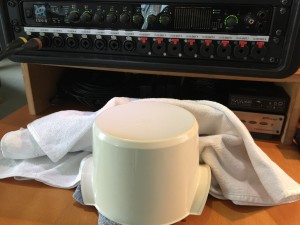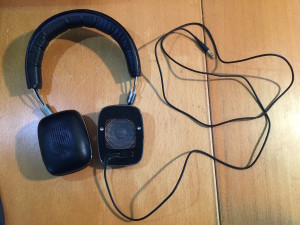I’ve recently witnessed and been part of a few debates about high-resolution audio, in particular related to the Pono Player. Many people claim that it makes no sense to use better than CD quality, while others (like me) do think it makes a meaningful difference.
During those discussions, I also brought up that cables could influence analog sound, which was disputed by even more people. I personally changed my electric guitar cable from a pre-made Klotz cable to one that I soldered myself using expensive Grindycop Beast bulk cables from Sommer Cable. Since I did that, my clean guitar sound became better than ever before and I’ve received quite a few positive comments from people asking how I achieved the sound. The cable played a significant role. It thus made sense to me that higher quality cables for listening could also positively influence the sound.
Custom headphone cables
My curiosity got the better of me, and a few months ago I jumped onto a Black Friday deal and ordered custom cables for my Westone ES5 in-ears and my Bowers & Wilkins P5 Series 2 headphones from Double Helix Cables. I received them two months later and when I tried them out, I thought there was a clear difference, not necessarily in the sound quality itself but very noticeable in the sound stage. My initial reaction was that it felt like barriers were removed and I described it in an email to Peter from Double Helix like this: “it’s a surreal experience, I feel like I’m floating in space with sound around me and inside me“.
Attempt at something scientific
This weekend, the skeptical scientist in me started wondering though. Was this difference just placebo as so many people claim? Do I really hear a difference or do I want to hear a difference? I thus decided to try to capture the difference in sound using my P5 Series 2 headphones and a ‘head’ that I assembled out of a kitchen bowl, towels and a matched pair of Avenson STO-2 omni microphones, all firmly taped together! 🙂
The bowl I used has ears on the sides, which allowed me to precisely position the headphone cups vertically and I then visually aligned them so that the tip of the microphones would be placed in the middle of the cups. I obviously took special care when placing the headphones on the microphones to make sure that the position was as much as humanly possible identical for all takes.
 |
 |
I then played the same music through the Pono Player, each time with different cables, recorded through my Metric Halo ULN-8 audio interface with a 96kHz/24bit resolution inside Audacity. The P5 headphones make it very easy to change the cables, you can just remove one of the magnetically attached pads and plug in a different cable.
 |
 |
The outcome
When listening back to the recordings, I found that most of what I perceived as improvements with the custom cables was lost. Probably due to the microphones, my improvised head contraption, the recording process, … However, the essence of the difference still seemed to be there. To make sure I was not imagining things, I asked my girlfriend to listen to the takes and to tell me what she thought, without me being present.
She was not there during the recording, doesn’t have any experience with the headphones nor the cables, and I just told her how to switch between tracks in Audacity for listening. After 30 seconds she stopped and asked if the top recording corresponded to the custom cable because she could better hear certain details while the overall volume and sound remained very similar. She was correct and this also corresponds to what I discern.
So, do cables matter?
I’m glad to know that I’m not imagining things when using higher-end cables, but obviously the benefit is totally related to what’s personally important to you. The original cable stills sounds wonderful, I just think the custom cable provides an extra few percent that pulls the sound out of the artificial realm and into a more realistic realm. With certain recordings, when I close my eyes, it feels like the artists are performing just for me, in the same room. To make that’s worth $100 since it triggers emotions that are absent otherwise.
Show me the goods
If you want to listen to the recordings from this experiment for yourself, you can download an excerpt from here. This zip archive contains 96kHz/24bit WAV files, captured raw from the microphones in the setup explained above. You obviously need a suitable DAC and headphones/monitors to evaluate the differences. Note that this is copyrighted material from Moloko’s Statues album. I hope that having re-recorded it and merely providing fractions of the songs will not be causing me any problems. If it does, I’ll have to take the link down.



Very interesting. Glad someone is trying to test cables. Will listen to this and seevwhat I think.
This is not really a valid scientific experiment. A valid experiment would require that you not knowing which samples were which, that everything was exactly the same for every run, and a statistically valid number of responses, like for example 100 tests with other people. Unfortunately you know too much about your test to detect or remove your own biases. Your girlfriend knows too much about you and will easily detect your biases to give the right answer. Psychology is working against you in this situation. Monster cable built very large successful business selling pretty looking and very expensive wire even though time and again it was proven that with valid scientific testing methodology no difference can be perceived. Nor can any difference be measured electrically in the bandwidth that humans can perceive.
http://www.allaboutcircuits.com/vol_2/chpt_14/5.html
We humans are interesting. Parent’s convince themselves that vaccines are dangerous, people go see psychics and believe they can see the future, people believe in ghosts, that the foot of a rabbit influences events in their favor, that CO2 emissions are not changing the climate, etc. Correlation is not causation. However for most complex phenomena that is outside of our expertise, it is very easy to tell ourselves a story and believe that rather than do the slow laborious work to really understand something.
That’s the eternal discussion that keeps popping up. Even though I’m a very technical guy, I disagree with you. There are things that we can’t measure and science often skews things. Typical example is only focusing on what our ears can hear when listening to music, as if that is the only sense that comes into play. Music is about emotion and feelings, unless you can univocally measure that, there’s little point to try to come up with a scientifically correct experiment.
Getting back to my girlfriend. I don’t see how she could be biased. I was not present when she compared by herself and she wasn’t there when I recorded. She was just thrown two waveforms with generic names in her lap and had a go at it. The handoff even didn’t happen with me in front of the screen so I couldn’t have given any subliminal cues either.
Apart from that, I can perfectly well be honest with myself. There were songs where the change in cables was imperceptible to me, no matter how hard I tried. With most of them those, the difference was enough and very welcome.
Late to the party but:
1. Love your work 🙂 Waiting for a video of what you can do with the Linnstrument and a Sub 37!
2. This test is missing a control, is not double blind and n=1 or 2.
3. “Sounding better” is very subjective. If I made you a cable which boosted the bass and treble, maybe it would sound “better”. A better test would be along the lines of calculating the delta between the original waveform and the recorded waveform using each cable. Closer = better, although both will of course be way off due to the headphones / acoustics.
Hi Geert
I work in a research lab and we ask animals to listen to stuff and tell us if the sounds are different and if so identify them. Now the interesting thing is Hens ( in our lab) dont read hifi/music mags, online reviews etc- as a result they have no placebo effect at all. ( we have never tested cables as its not the function of the lab) However what is interesting is when you ask the birds to discriminate on the first day they can not tell the difference – typically by the 30 day they are responding as accurately as they ever will.
What this tells us is discrimination between two sounds is not a discrete thing (an idea psychology gave up 90 years ago) instead discriminations are learned over time. I guess that you have experienced this – your ability to hear the effect of very tiny movements on a eigen key now is different from the first time. Irrespective, an AB test on any day is some where along that 30 day learning curve – but in truth it is almost always at day one on that curve ie a new cable/sound – thus the popular conclusion that “See science show you can not tell the difference”. I think this is also why many HiFi review types stopped AB testing years ago
Cheers